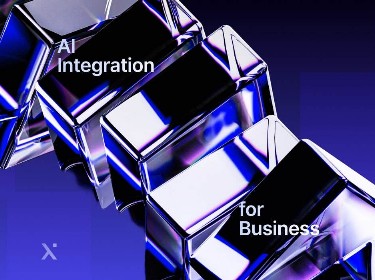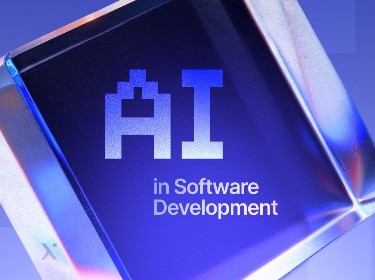AI in transportation became the ghost in the machine, the unseen navigator, the tireless analyst poised to figure out the tangled mess of our global arteries and, just maybe, make getting around less of a daily battle.
If you’re in the transportation or logistics game today, in mid-2025, you’re likely wrestling with volatile fuel prices that seem to have a mind of their own, the relentless demand for “just-in-time-yesterday” deliveries, a driver and skilled labor crunch that keeps you up at night, and supply chains so complex they make spiderwebs look straightforward. It’s a high-pressure, tight-margin world where just “keeping up” feels like a win.
We’re now at a point where AI in transportation is becoming a practical, and often indispensable, toolkit for businesses scrambling for an edge. The global “AI in Logistics” market, for instance, was valued around $18 billion in 2024 and was projected to leap to over $26 billion by this year, 2025 – that’s a staggering growth rate (some analysts pegged it around 46% CAGR).
Why such an explosion? Because forward-thinking companies are seeing genuine results. Some reports indicate businesses implementing AI in their logistics are slashing operational costs by up to 15-30% through smarter routing and predictive maintenance alone. And on the safety front, the potential is even more profound, with ongoing research suggesting that sophisticated AI-driven systems could significantly reduce the nearly 90% of road accidents attributed to human error.
That’s exactly why the team of our dedicated AI development specialists and analysts gathered their collective expertise and on-the-ground insights to develop this comprehensive article. Our single goal? To provide your business with a clear, actionable understanding of how to strategically and smartly use AI.
How is AI used in transportation?
![]()
To truly grasp the impact, we need to understand how is AI used in transportation. It’s not a single, monolithic entity but rather a suite of technologies working in concert. Key AI disciplines at play include:
- Machine learning development (ML): The workhorse, allowing systems to learn from data without explicit programming. This powers everything from predictive maintenance that foresees a breakdown before it strands you, to dynamic pricing in ride-sharing that fluctuates with demand.
- Computer vision: Giving machines “eyes” to interpret the visual chaos of our roads. This is the bedrock of autonomous vehicles identifying a pedestrian versus a plastic bag skittering across the asphalt.
- Natural Language Processing (NLP): Bridging the communication gap between humans and machines. Voice-activated infotainment systems that actually understand your mumbled request for that obscure podcast, or AI chatbots handling complex travel inquiries.
- Deep learning: A sophisticated subset of ML using multi-layered neural networks to decipher incredibly complex patterns. This is what allows an AV to recognize the blizzard or distinguish subtle cues in a crowded urban area.
- Robotics: The physical embodiment of AI’s decisions – the autonomous vehicle itself, the warehouse sorting bot, or the delivery drone navigating to your door.
Combined, these elements play in harmony. An autonomous delivery bot, for example, uses computer vision to “see” its environment, machine learning to plot the safest path through a bustling sidewalk, and robotics to physically move.
Top 7 Use Cases of AI in Manufacturing
How to Implement AI-based Recommendation System
Benefits of AI in transportation
![]()
The drive towards an AI-infused transport sector is fueled by a number of potential upsides. The benefits of AI in transportation are multi-faceted, promising to touch nearly every aspect of how we move.
Radically enhanced safety
This is the headline act. Human error remains the villain in an overwhelming majority of traffic incidents. AI, with its unblinking attention, 360-degree sensory input (for equipped vehicles), and reaction times unbound by biology, promises a dramatic reduction in collisions, injuries, and fatalities. Advanced Driver-Assistance Systems (ADAS) are already proving their worth, and the prospect of fully autonomous systems holds the potential for an even greater leap in road safety.
Unprecedented productivity
AI-powered traffic management can optimize signal timings, predict and mitigate congestion, and guide vehicles along the most efficient routes. In logistics, this translates to optimized fleet operations, reduced fuel consumption, and faster delivery times. For individuals, it means less time stuck in traffic and more predictable journeys.
Environmental responsibility
While AI computation itself has an energy footprint, its application in transportation can lead to significant green gains. Optimized routing, smoother driving patterns in AVs (reducing harsh acceleration and braking), platooning of trucks to reduce wind resistance, and enhanced management of electric vehicle (EV) charging networks all contribute to lower fuel consumption and reduced greenhouse gas emissions.
Improved accessibility and equity
Autonomous vehicles, in particular, hold the promise of providing independent mobility for a wider range of people, including the elderly, individuals with disabilities, and those in areas poorly served by traditional public transport. AI-driven on-demand services can also make transportation more tailored.
Enhanced user experience
From personalized journey planning that considers your preferences and real-time conditions, to infotainment systems that learn your habits, to seamless intermodal travel where your entire trip across different transport modes is orchestrated by AI, the journey itself is set to become more comfortable, convenient, and less stressful.
Economic advantages
Beyond fuel savings, AI can reduce operational costs through predictive maintenance, optimized staffing, and reduced accidents (and associated insurance/repair costs). It creates new industries and job roles focused on AI development, deployment, and maintenance within the transportation sector.
AI in transportation: examples
![]()
The theoretical applications are impressive, but where is this technology already making a tangible difference, and what’s just around the corner? Let’s explore some concrete AI in transportation examples in more detail.
Autonomous Vehicles (AVs)
Self-driving cars & robotaxis: The slow but steady rollout of robotaxi services in controlled environments (like specific city districts) by companies such as Waymo and Cruise is a clear indicator. These services aim to provide on-demand, driverless transportation, potentially reshaping urban mobility and car ownership models.
Autonomous trucks: Long-haul trucking is a prime candidate for automation. AI-driven trucks can operate for longer stretches, optimize fuel through techniques like platooning (electronically linking trucks in a convoy to reduce drag), and address driver shortages. Companies like TuSimple and Aurora are heavily invested here.
Last-mile delivery drones: The final leg of delivery is often the most complex and expensive. AI-powered drones (e.g., Zipline for medical supplies, Amazon Prime Air for packages) and sidewalk robots (e.g., Starship Technologies) are being deployed to offer rapid, automated delivery for smaller consignments.
Public transit: In controlled environments like university campuses, airports, and planned communities, autonomous electric shuttles are emerging as a solution for first/last-mile connectivity, operating on fixed or semi-flexible routes.
Check out our recent case: digital twin-powered smart warehouse automation system for a big retailer
Intelligent infrastructure management
This is where AI for transportation meets the tarmac and rails.
Adaptive traffic signals: Cities worldwide are implementing AI systems that analyze real-time traffic data from cameras, sensors, and connected vehicles to dynamically adjust signal timings, easing congestion hotspots and even predicting traffic jams minutes or hours in advance, allowing for proactive rerouting.
Smart parking: AI-powered systems can monitor parking space availability in real-time (using cameras or ground sensors) and guide drivers to empty spots via apps, reducing the frustrating circling that contributes to congestion and emissions.
Infrastructure monitoring: Drones and vehicles equipped with AI and computer vision can inspect roads, bridges, and railway lines for defects (cracks, potholes, wear) far more efficiently and frequently than manual methods, enabling predictive maintenance and enhancing safety.
More convenient public transportation
Personalized journey planning: AI algorithms are getting better at creating truly multi-modal journey plans that consider not just time and cost, but also user preferences (e.g., fewer changes, preferred modes, accessibility needs) and real-time disruptions.
Demand-Responsive Transit (DRT): AI optimizes routes and schedules for on-demand buses or shuttles in real-time, matching vehicle supply with passenger requests. This makes public transport viable and efficient in areas with lower or more dispersed demand.
AI for crowd management & security: In busy transit hubs, AI analyzes CCTV footage to detect overcrowding, unusual behavior, or security threats, allowing for quicker intervention and improved passenger safety.
Logistics and supply chain efficiency
Automated warehouses (dark warehouses): AI controls robots for picking, packing, sorting, and moving goods 24/7 with minimal human intervention, drastically increasing throughput and accuracy.
Predictive analytics for supply chain resilience: AI models analyze vast datasets (weather, geopolitical events, shipping movements, supplier performance) to forecast potential disruptions, allowing companies to proactively adjust routes, inventory, or sourcing.
Business intelligence in document processing: AI automates the extraction and processing of information from shipping documents, customs forms, and invoices, reducing manual effort and errors in a paper-heavy industry.
What is an example of artificial intelligence in transportation? Consider the advanced air traffic management systems currently under development. These systems use AI to analyze real-time data from aircraft, weather systems, and airport operations to optimize flight paths, manage airspace more dynamically, and predict potential conflicts far earlier than human controllers alone.
Top 10 AI Software Development Companies 2025
What Are AI Agents: Types, Examples, and Benefits | Article by PIxelPlex
How AI Empowers Digital Transformation Across Industries | Article by PixelPlex
Trends for 2025 and beyond
![]()
The current applications are just the beginning. Artificial intelligence in transportation is a hotbed of innovation. Looking towards 2025 and beyond, several key trends are poised to redefine how we move:
AI and in-vehicle supercomputing
Decisions in autonomous driving need to be made in milliseconds. This is driving a shift towards processing more AI tasks directly within the vehicle (edge computing) rather than relying solely on the cloud. Expect more powerful, specialized AI chips and in-vehicle supercomputers.
V2X (Vehicle-to-Everything) communication
AI will leverage seamless communication between vehicles (V2V), infrastructure (V2I), pedestrians (V2P), and networks (V2N). This interconnectedness will allow vehicles to share real-time data about hazards, traffic flow, and intentions, creating a cooperative ecosystem for enhanced safety and efficiency.
Mobility-as-a-Service (MaaS) 2.0
AI will enable MaaS platforms to offer incredibly tailored transportation solutions. Imagine a subscription service that learns your travel patterns, preferences (cost vs. speed, comfort levels, carbon footprint), and dynamically bundles the best mix of public transport, ride-hailing, bike-sharing, or even autonomous pods for your daily needs.
Explainable AI (XAI)
As AI systems make more critical decisions, the “black box” problem becomes a major hurdle. XAI aims to make AI decision-making processes transparent and understandable to humans. This is crucial for regulatory approval, accident investigation, and building public trust in autonomous systems. We’ll see more demand for AI that can explain why it made a particular maneuver.
AI decarbonization
Beyond route optimization, AI will play a critical role in managing EV charging infrastructure (predicting demand, optimizing charging schedules, facilitating grid balancing), optimizing energy consumption in public transport fleets, and enabling the development of more efficient and lighter materials for vehicles through AI-driven material science.
Advanced sensor fusion and perception
Future AI systems will integrate data from an even wider array of sensors (including next-gen LiDAR, radar, thermal cameras, and even unconventional sensors) with greater sophistication. This will lead to “predictive perception,” where AI anticipates the behavior of other road users and potential hazards with even greater accuracy and foresight.
Maturing regulatory frameworks
As the technology matures, governments and international bodies will establish more comprehensive regulations for testing and deploying AI in transportation, particularly for AVs. Expect more focus on standardized safety protocols, data governance, and ethical AI development principles.
And another cool case for your consideration – AI-based shared grocery shopping list app
Concerns and ethical considerations
While the promise of AI for transportation is undeniably seductive, the path to this automated world is littered with significant challenges and ethical landmines that demand careful navigation. Ignoring them would be like admiring the shine on a new car while ignoring the engine warning light.
Ethical dilemmas & bias
The trolley problem multiplied: The classic dilemma of choosing the lesser of two evils in an unavoidable accident scenario is just the tip of the iceberg. How should an AV be programmed? To prioritize occupant safety above all else? To minimize total casualties? To value younger lives over older ones? There are no easy answers, and encoding these decisions into algorithms is fraught with peril.
Bias in, bias out: AI systems learn from data. If historical data reflects societal AI biases (e.g., certain neighborhoods being over-policed, leading to biased data for predictive policing in transport security), the AI can perpetuate or even amplify these biases. This could manifest in AVs being overly cautious around certain demographics or unfair allocation of on-demand transport resources.
Data privacy
AI-driven transportation systems are data gluttons. They collect vast amounts of information about our movements, habits, preferences, and even conversations within vehicles. Who owns this data? How is it being used? Is it anonymized effectively? The potential for misuse is immense. Strong data security and privacy-preserving techniques are critical.
Cybersecurity
As vehicles become more connected and reliant on complex software, they become attractive targets for cyberattacks. Malicious actors could potentially disrupt traffic flow, take control of vehicles, steal personal data, or even cause accidents. Ensuring robust, multi-layered cybersecurity for both vehicles and the supporting infrastructure is a monumental task.
The job question
The prospect of widespread automation, particularly in trucking and taxi services, raises serious concerns about job displacement for millions of professional drivers. While new jobs will be created in AI development, data science, and AV maintenance, there’s a potential mismatch in skills and geographic location. This necessitates proactive strategies for retraining, social safety nets, and potentially exploring concepts like Universal Basic Income.
Over-reliance and skill atrophy
As we cede more control to automated systems, there’s a risk of human skills (like driving or navigation) deteriorating. This could be problematic if systems fail or in situations requiring human intervention. Maintaining a balance and ensuring humans can safely retake control is vital.
Environmental cost of AI itself
While AI can optimize for environmental benefits, the training of large AI models consumes significant amounts of energy. The production of specialized hardware also relies on rare earth minerals, often sourced with considerable environmental and social impact. The net environmental benefit needs careful and continuous assessment.
Addressing these concerns requires a multi-stakeholder approach involving technologists, ethicists, policymakers, businesses, and the public. It’s about fostering responsible innovation from the side of humanity.
Now, you might be looking at the diverse AI technologies and their potential applications and wondering, “This is powerful, but where do we even begin?”.
This is precisely why engaging an experienced AI development company is often not just a helpful step, but a strategic imperative for your transportation or logistics business. An established firm brings to your project:
- Deep technical expertise: Proven experience in the core AI disciplines, tailored to real-world problems.
- Industry-specific insights: Many experienced AI companies have worked on projects within or related to the transportation and logistics sector, understanding its unique data challenges, operational nuances, and regulatory landscape.
- Strategic roadmapping: They can help you identify the AI opportunities with the highest ROI for your specific business, avoiding costly diversions into projects that aren’t strategically aligned or technologically feasible.
- Robust development: From data acquisition and preparation to model training, rigorous testing, seamless integration with your existing systems, and ensuring scalability and ongoing maintenance, experienced teams follow proven processes.
- Faster time-to-value: Partnering with experts accelerates your journey from AI aspiration to tangible operational improvements and a stronger competitive stance in artificial intelligence in the transportation industry.
Conclusion: charting a course with wisdom
Overall, the real challenge about AI isn’t engineering smarter machines, but becoming wiser architects of these complex, interwoven systems and about fostering a critical dialogue around the AI in transportation revolution.
Choosing the right AI development vendor is arguably one of the most critical investments your transportation or logistics business will make in this era of intelligent transformation. It’s about forging a strategic alliance with a team that can translate the potential of the AI in transportation into robust, and value-driven solutions for your unique challenges.
By carefully evaluating potential partners, you equip your business not just to adapt to the AI-driven future, but to actively shape it and lead the way.
Let’s buckle up and expand this exploration – start with dropping a message to our team and telling us about your idea.
FAQ
Key benefits include: increased operational efficiency & cost reduction, enhanced risk mitigation, improved customer experience, better demand forecasting, real-time tracking, personalized delivery options, and quicker response times.
By analyzing sensor data, AI can forecast potential equipment failures before they occur, allowing businesses to schedule maintenance proactively. This minimizes costly unplanned downtime, extends asset lifespan, and improves overall reliability and safety.
A smart first step is to identify a specific, high-impact business problem or inefficiency you believe AI could solve, rather than trying to implement AI broadly at first. Consider a pilot project focused on this area. Alternatively, engaging with AI experts for an “AI readiness assessment” or a strategic consultation can help you identify the most promising opportunities and develop a clear roadmap.
While AI will automate certain tasks, it’s more likely to transform roles rather than eliminate them entirely. Many AI applications are designed to augment human capabilities, helping your team make better decisions or focus on more complex tasks. For example, drivers might be assisted by AI safety systems, and planners might use AI tools for more sophisticated analysis.
For logistics software development in 2025, considering AI is critical not just for competitive advantage but increasingly for operational necessity. Early adopters are already reaping benefits in efficiency and service. Waiting too long risks falling behind in a sector where margins are tight and customer expectations for speed and reliability are always increasing.
Partnering with an experienced AI development company offers several advantages: immediate access to specialized talent (data scientists, AI engineers), reduced development time and risk, and strategic guidance based on cross-industry experience. They can help you navigate the complexities more effectively than often possible with in-house efforts, especially when starting out.




